Last month I was delighted to be able to visit Thenford, Northamptonshire on one of its open days. A very private and expansive garden it is the stately home of Lord and Lady Heseltine who acquired it in 1976.
As we swept through the imposing gates we had no idea what to expect, other than we knew there was a walled garden and an arboretum. The afternoon sunshine welcomed us in.

We thought this would be a pleasant distraction from the Covid troubles only to find as we parked in the field north of the house, that many other visitors were decked out in face masks; surely not necessary for an afternoon outside?
Heading straight ahead of us to the sunken rose garden which is south west of the house, it is the Barn owl which catches our eye; so realistic in its stance we wonder if it might take flight.

The roses, all helpfully labelled are understandably not at their best now but the putti provides entertainment instead.

This heavenly bench must be the perfect place to linger and enjoy the heady scent on a summer’s day.

We decide to visit the arboretum first and so take the path along the south front of the handsome Grade 1 listed house. On the lawn Guy Taplin’s graceful cormorants enjoy the unspoilt view from the ha ha.

October is the best time to visit an arboretum, and Thenford did not disappoint. An enviable collection of trees; approximately 4,000 different types. The maples (Acers) in particular are in glorious technicolour, some have turned golden

others bright red, and all showing how nature can age so majestically.

The berries delight too, from the simple Spindle Euonymous hamilton English Charm,

to the scarlet berries of the Rowan Sorbus matsumuranu

and to the small black berries of Aronia melanocorpa grandiflora, the black Chokeberry.

Take a look at the litchen growing on the bark and how well-armed is the trunk of Gleditsia japonica koraiensis.

The arboretum is spread out over 70 acres and, following the path through there are tranquil glimpses of pasture, sheep and lake.

There are some 113 champion trees (individual trees that are exceptional examples of their species because of their enormous size, great age, rarity or historical significance) here planted well before the Heseltines arrived here, however this young liquidamber demonstrates that planting is ongoing.
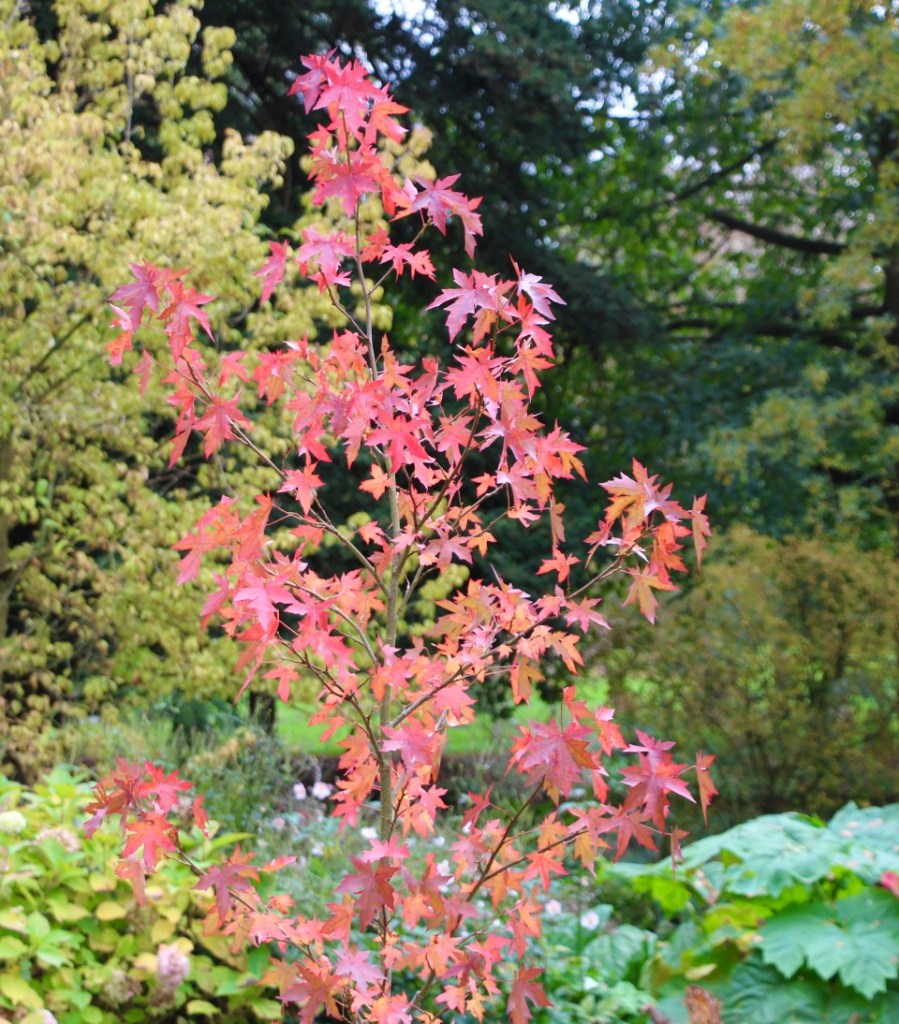
A few flowers are evident, the white flowers on the Viburnum plicatum f. tomentosum ‘Dart’s Red Robin’ determinedly project upwards,

and the low growing shrub Heimia salicifolia which has tiny yellow flowers. Native to S. America you can obtain your legal high from this little gem but, I am informed, it is quite short lived.

It is also a watery landscape with the three medieval fish ponds planted decoratively with not only trees but also a diverse selection of shrubs and perennials, with an abundance of bridges that span and reflect; there is a green, a red,

a blue

and a neat brick, the shape of which

is similar to that of the ice house.

Sited above the fishponds and best viewed from near the ice house is the parish church of St Mary caught in the afternoon sun.

In such a vast area benches are a necessity and so often in public spaces they are there to commemorate a person. This one, a birthday present from the grandchildren, perhaps touchingly displays something of the owner’s character ‘Grandpa to sit and scheme’.
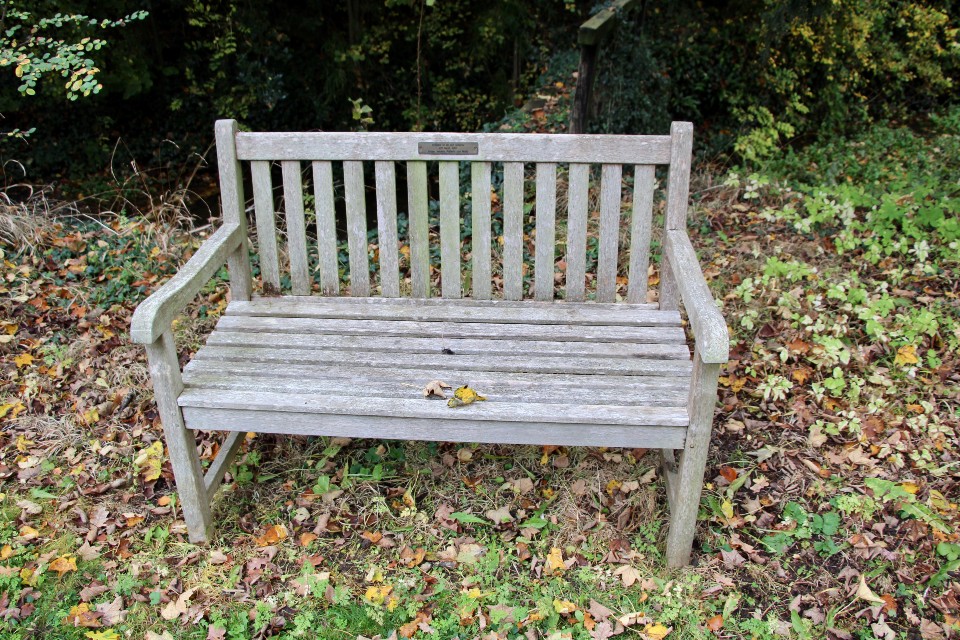
The leaves beneath our feet give off a delicious aroma of caramel; they have fallen from the Katsura tree, Cercidiphylum japonicum.
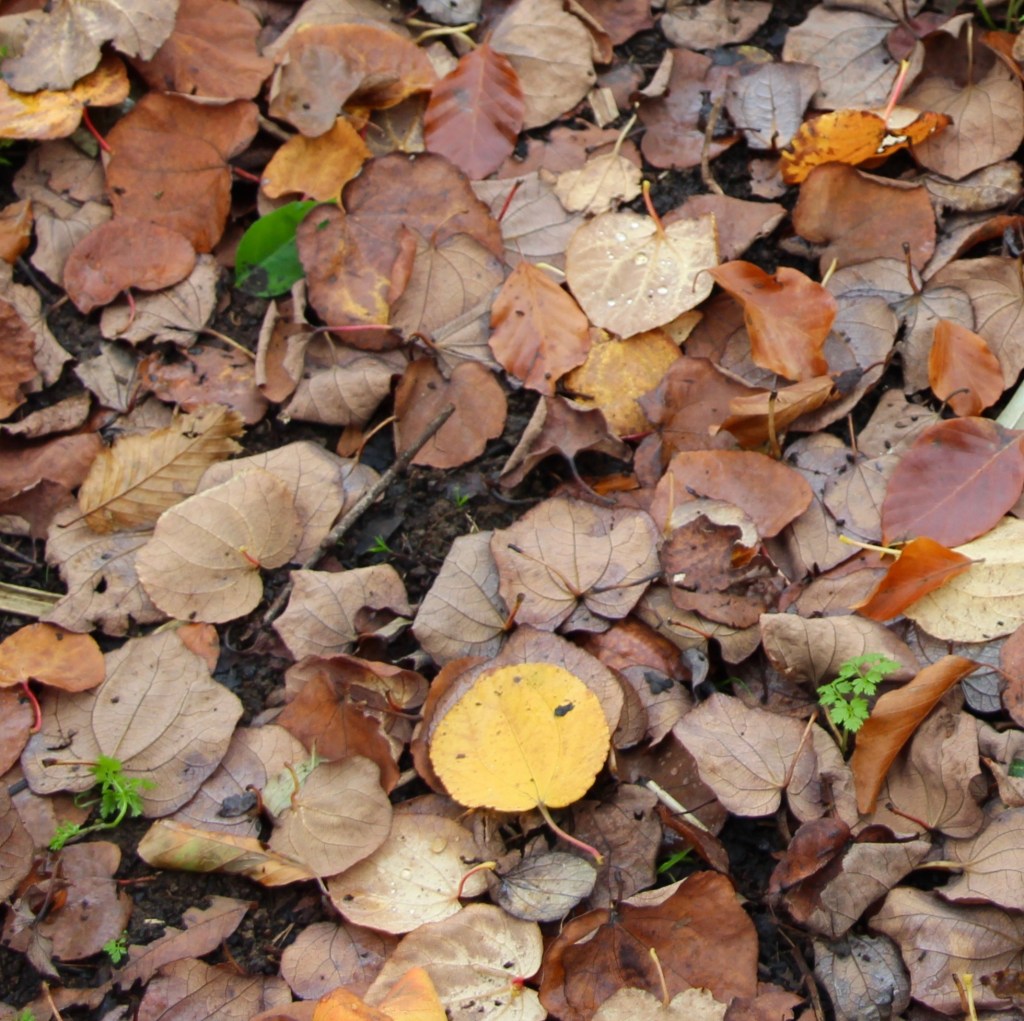
It is hard to believe that a tree trunk could be quite so white; in this grove the low sun highlights the brilliance of the silver birches.

Moving on we come to yet more water, the New Lake where reflections seem brighter than the actual image.
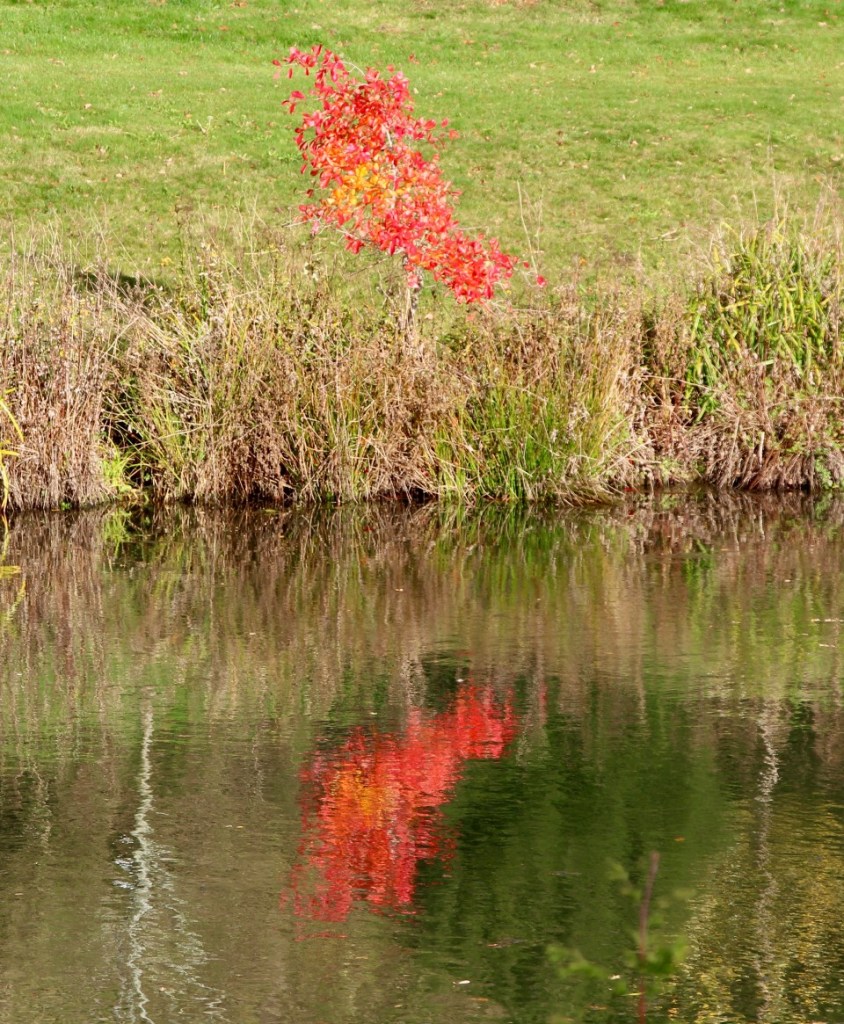
Along the lake is a gathering of humble but handsome hawthorns, cratageus crus galli,
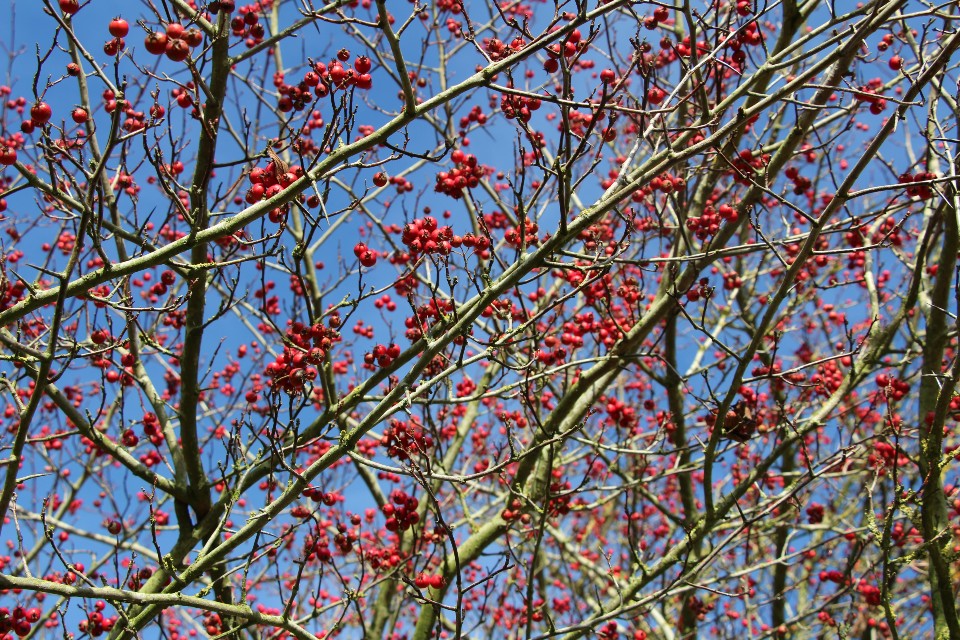
similar but smaller cratageus canbyi
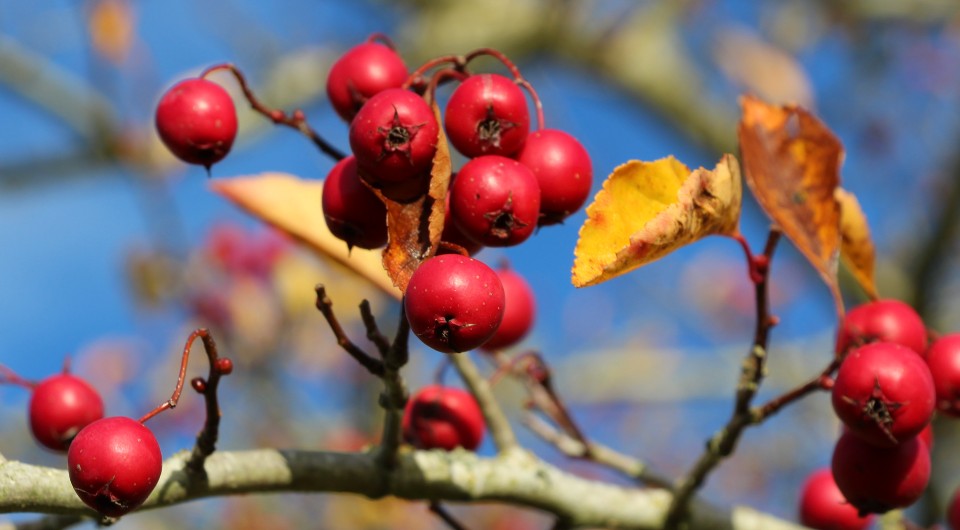
and looking good enough to eat, the orange-coloured hips of cratageus x lavallei carrierei.
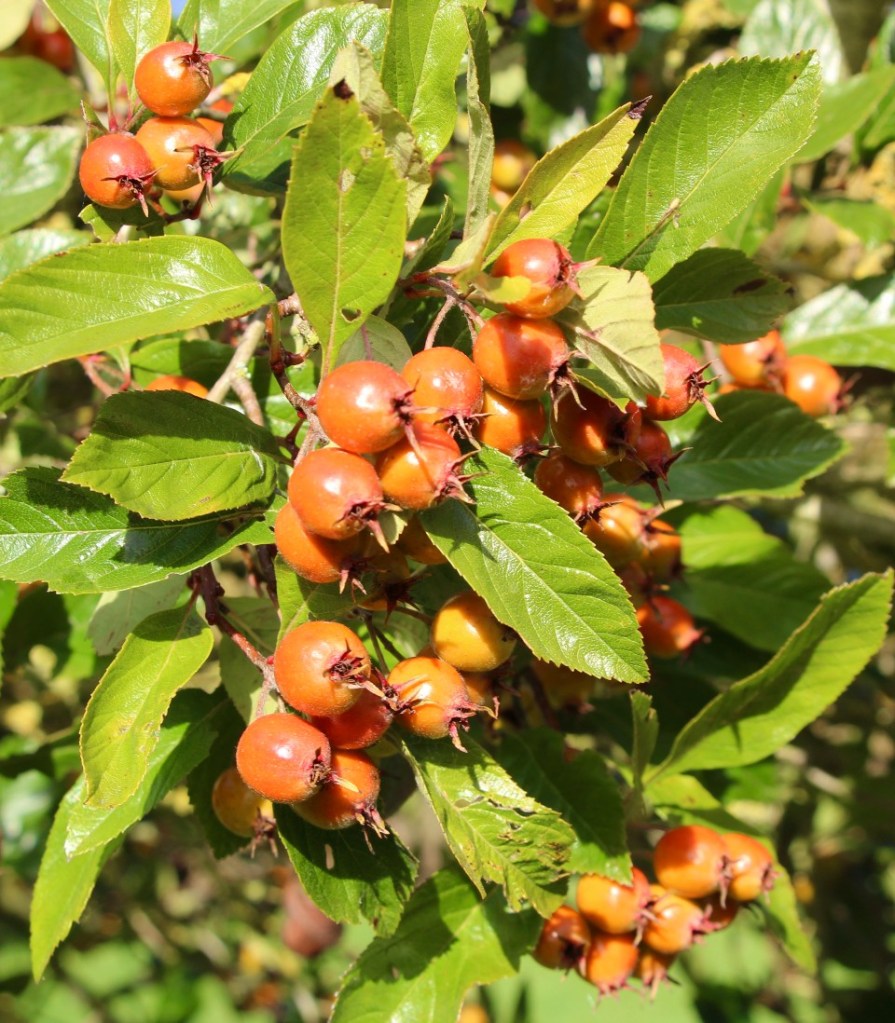
This is the southernmost tip of the arboretum and before turning back we pause awhile and admire what has been achieved here over the past forty odd years and wonder what it will look like in another forty years.

On the hillside we come across three conifers looking like some weird and wonderful beasts.

Passing the house again we head for the walled garden over on the east side and find in Lannings Walk this wicked little chap.
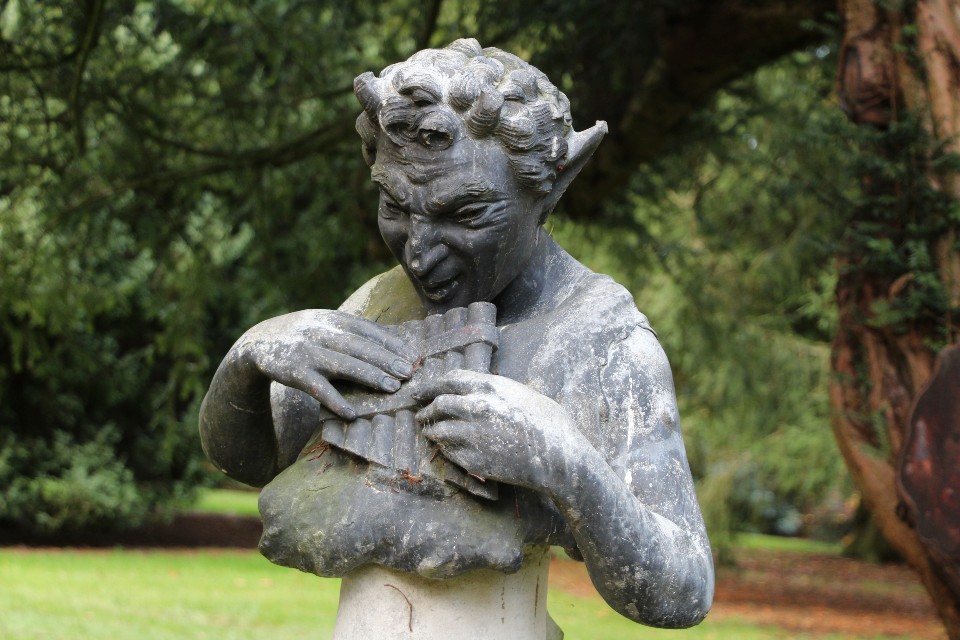
I make a mental note to plant cyclamen hederifolium, they brighten up any woodland floor.

Here and there ruined arches appear,
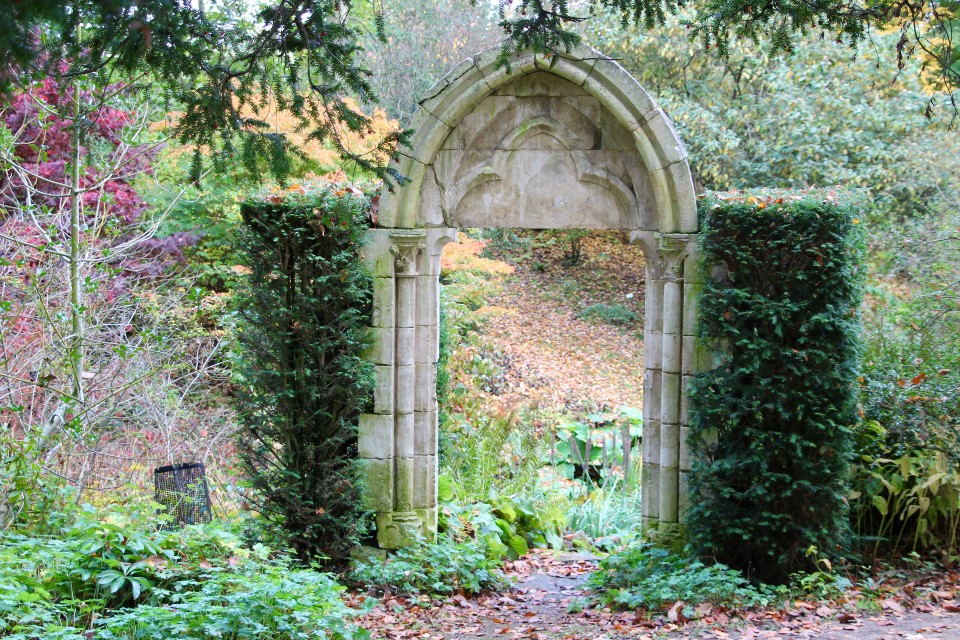
adding a little interest and a window through which to view yet more.
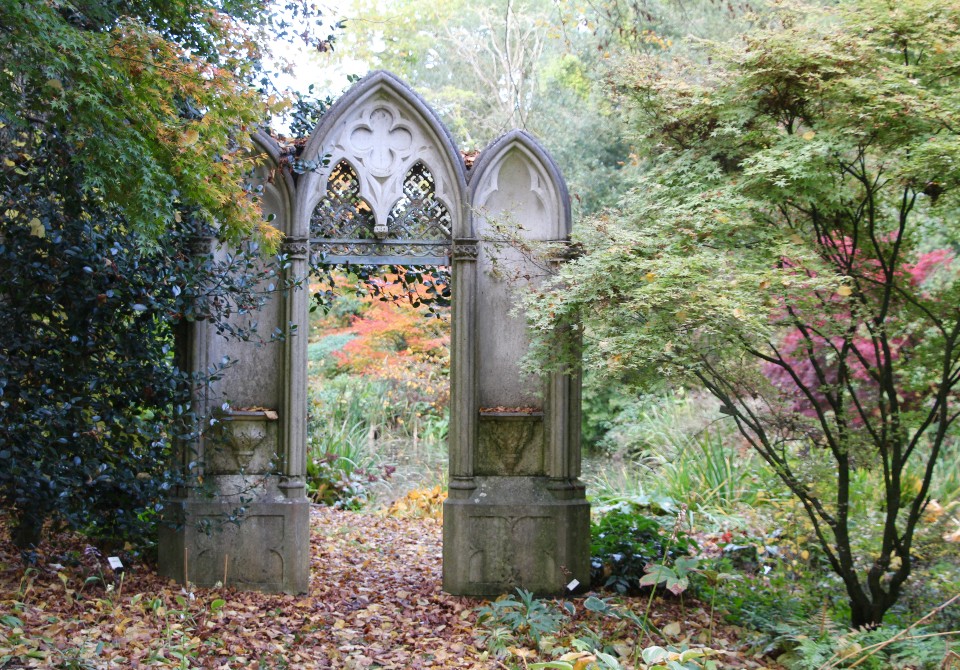
And what are these dark curious objects lying around the base of the tree?

Close inspection reveals they are fallen suits of armour.

Just to the right of the entrance to the walled garden is an amazing sight. These early snowdrops are not unusual in appearing now but how glorious they look amongst the maple leaves. This variety is Galanthus reginae-olgae ‘Tilebarn Jamie’ and is just one type out of 600 different snowdrop species grown here. Next February there are two afternoons scheduled for snowdrop walks.

It is a very different feel on entering the walled garden where we are greeted by marble elephants.

This space is very organised, neat and overwhelmingly geometrical, a complete contrast to what we have already experienced. Inspired by Andre Le Notre of Versailles and Vaux-Le-Vicomte fame, it was I understand sketched by Lord Heseltine, and then the designer George Carter made it happen. A more appropriate designer you couldn’t have as he specialises in formal gardens inspired by the simple geometry of 17th century gardens http://georgecartergardens.co.uk/. Incidentally George who lives in Norfolk will be opening his garden next year on Sunday 19th September for the National Garden Scheme.
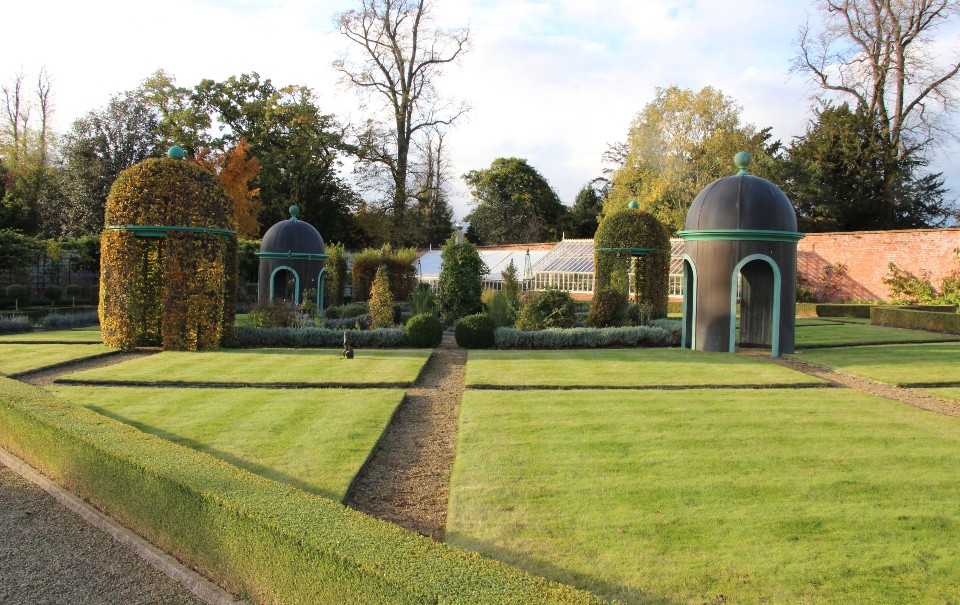
Paths criss cross systematically and continue through rotundas.

The walled garden covers two acres allowing enough space for sizeable greenhouses. There is even an aviary, and it is the call from these birds that is the only sound you hear in these enclosed walls.

In one corner is the head of Goliath, or is it Billy Connolly? Whoever he is he is cleverly in tune with the fig foliage behind.

In another corner diametrically across are two sentry boxes silently waiting to be sat in.

There is an area for vegetables but curiously these artichoke almost look out of place.

From all around you can see the central fountain.
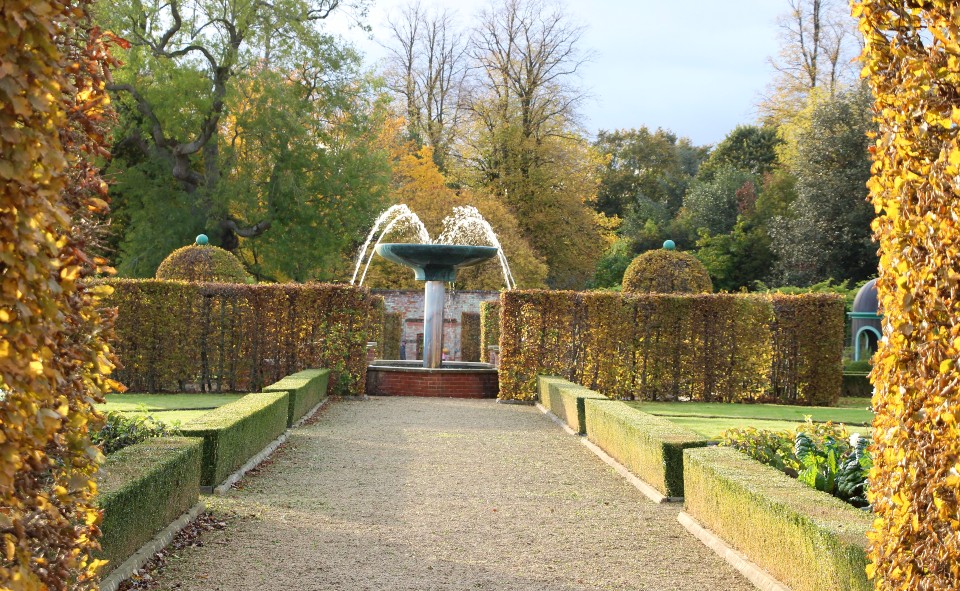
Outside the walls along the south side is a mixed border with all sorts of delights,

interspaced with elegant seats,

and across the strip of grass the border runs along the field side,

where metal moon windows invite you to look out across the distant countryside.

We make our way back through the trees in Lannings Walk,
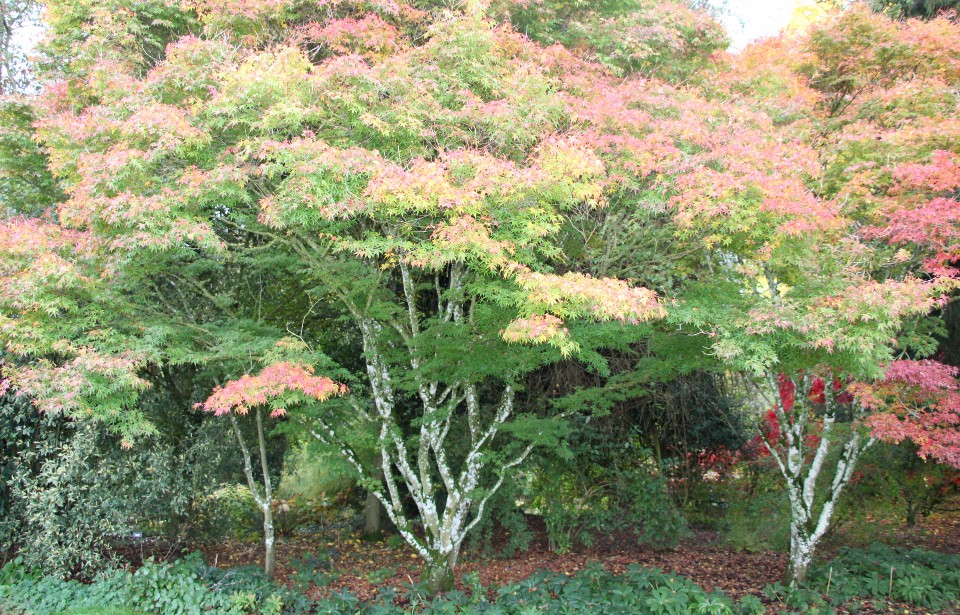
and into the field where the cars are parked. The head gardener is selling the Heseltine’s book and looking at the front cover I realise that we have missed the rill. He urges us to take a look (at the rill, not the book which is wrapped in plastic – covid precautions) and so we hurry back.

The light is fading as we hurry back to find the splendid rill bubbling away in all its glory.

Just below the rill, water plays off the broad leaf plant, and yes you might be forgiven for not realising it is made of metal.

Just further on we discover the Sculpture Garden. Oh my, how could we have missed this.
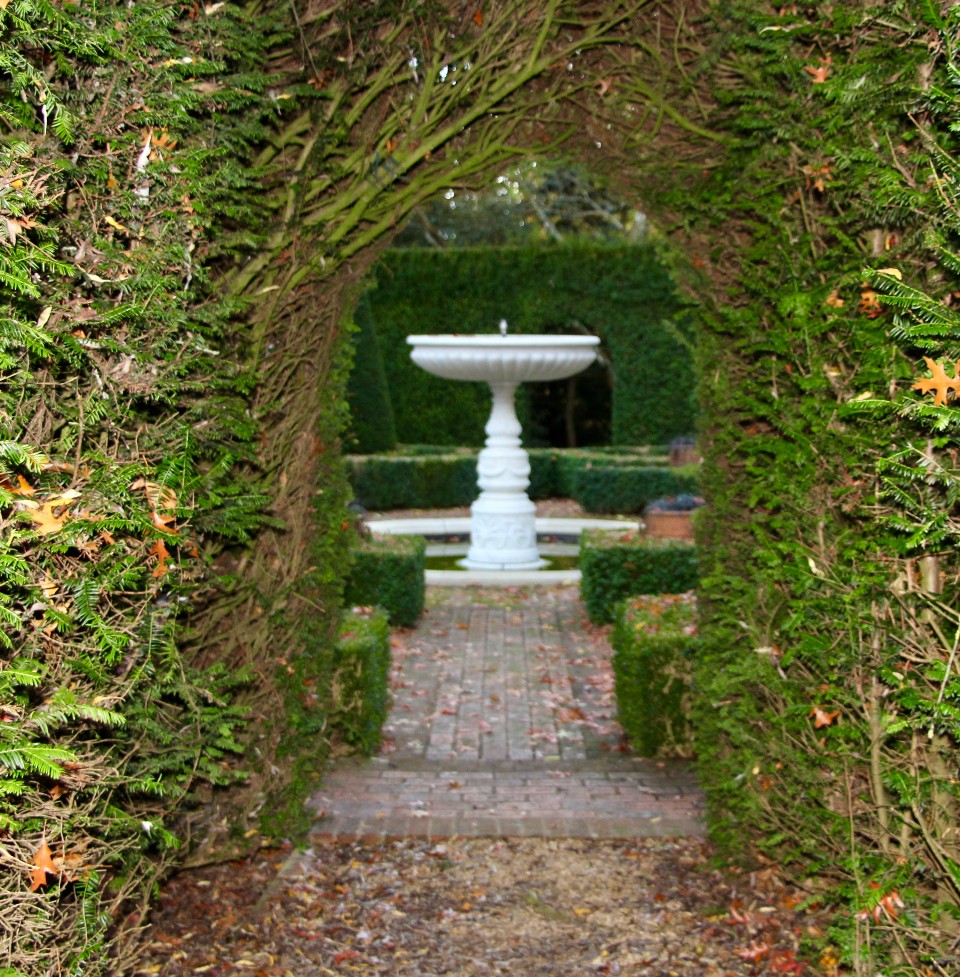
Sculptures, many of which are contemporary British, are displayed set out on the grass bays backed by beech. ‘The Dancers’ by Lilly Henry could be straight out of Strictly.

Gracefully tall and thin is ‘The Vessel’ made of slate and fibreglass and has been created by Maryanne Nichols, a sculptor from Suffolk,

and lying solidly on the ground is Ronald Rae’s ‘Head of John the Baptist’.
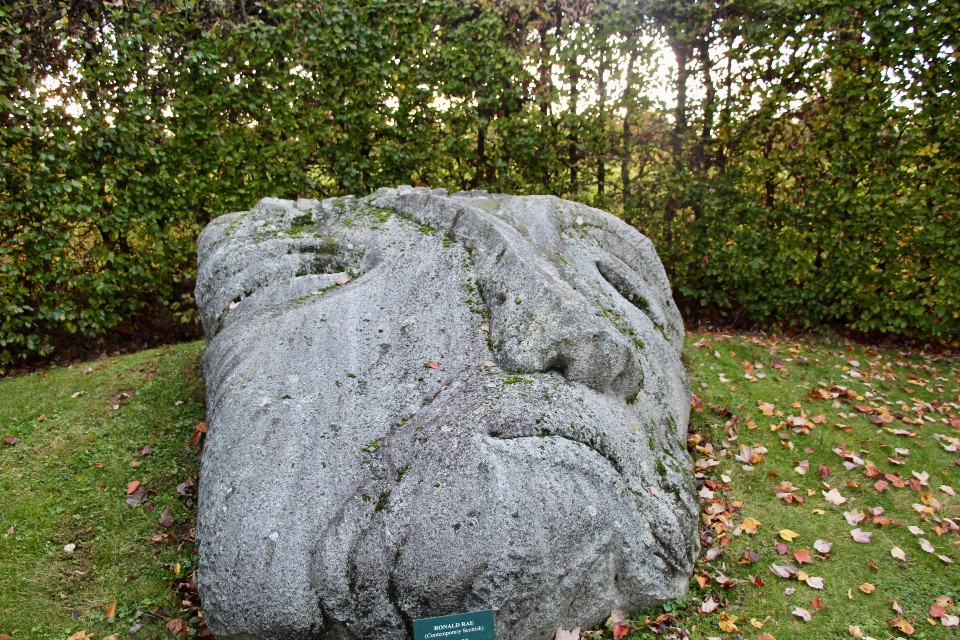
It is quite a collection; too many to include all, but Phillip Jackson’s gentle lady ‘Reading Chaucer’ is a delight although her pages are in fact blank.

Lastly we admire the massive ‘Head of Lenin’ by Dzintra Jansone which was removed from a town square in Preili, Latvia.

Returning to the car we slip past the watchful eye of the hounds on the lawn and say our goodbyes, and promising to return the Head Gardener advises us that May is the best time.

Our visit has indeed proved to be a wonderfully refreshing distraction with incidentally, not a face mask in sight.
Covid restrictions might have put garden visiting on hold for the moment but there is no harm in planning for next year: https://bookwhen.com/thenfordarboretum#focus=ev-sz8n-20210203130000
Lovely! We found some hedge shrubs on a walk in Claydon with the same flower as the Euonymous; i was going to ask you what it was when I next saw you! The leaves were red though, not yellow – perfect to include in any hedging we do, I thought
Get Outlook for iOS ________________________________
LikeLike
Good idea and when you move you can visit Thenford
LikeLike
Astounding… a champion garden and your evocative words distracted me from Covid… thank you.
LikeLike
What a lovely thing to read on a dark, damp November morning. Thank you.
LikeLike
I like your blog a lot – it’s very cheering with its beautiful photos and perfect prose. Loved your Thenford tour. So glad you’re keeping going.
LikeLike
Brilliant! Thank you Julia
Sent from my iPhone
>
LikeLike
Great blog-thank you Julia. Lovely to see it at another season- a nice reminder of our visit there about 9 years ago in high summer.
LikeLike
Fifty nine fabulous photograph accompanied by detailed descriptions has me enthralled
LikeLike
Another “Tour de Force”. Thank you Julia.
LikeLike
I love this blog. Please one question: What is the botanical name of the trees with pale-red autum leaves on LANNING’s walk? Thanks in advance for you replay.
LikeLike
They are acers but not sure which ones.
LikeLike
What a treat and the perfect time of year to do it. I was particularly struck by the snowdrops growing through the red acer leaves. I have a clump of G. reginae-olgae but how wonderful to have a pool of them.
LikeLike
I LOVED this garden tour! The “wilder” side, the arboretum with all its gay autumn colors, held my interest enough to make me pause and ponder. Fascinating sculptures in metal work, too, but the bench with the curved back is especially charming. At first I thought it was a wrought iron but, on closer inspection, I realized it’s wood.
LikeLike
Beautiful autumn colours, statuary and of course an Ice House!
LikeLike
Pingback: Galanthophilia...it’s a slippery slope...